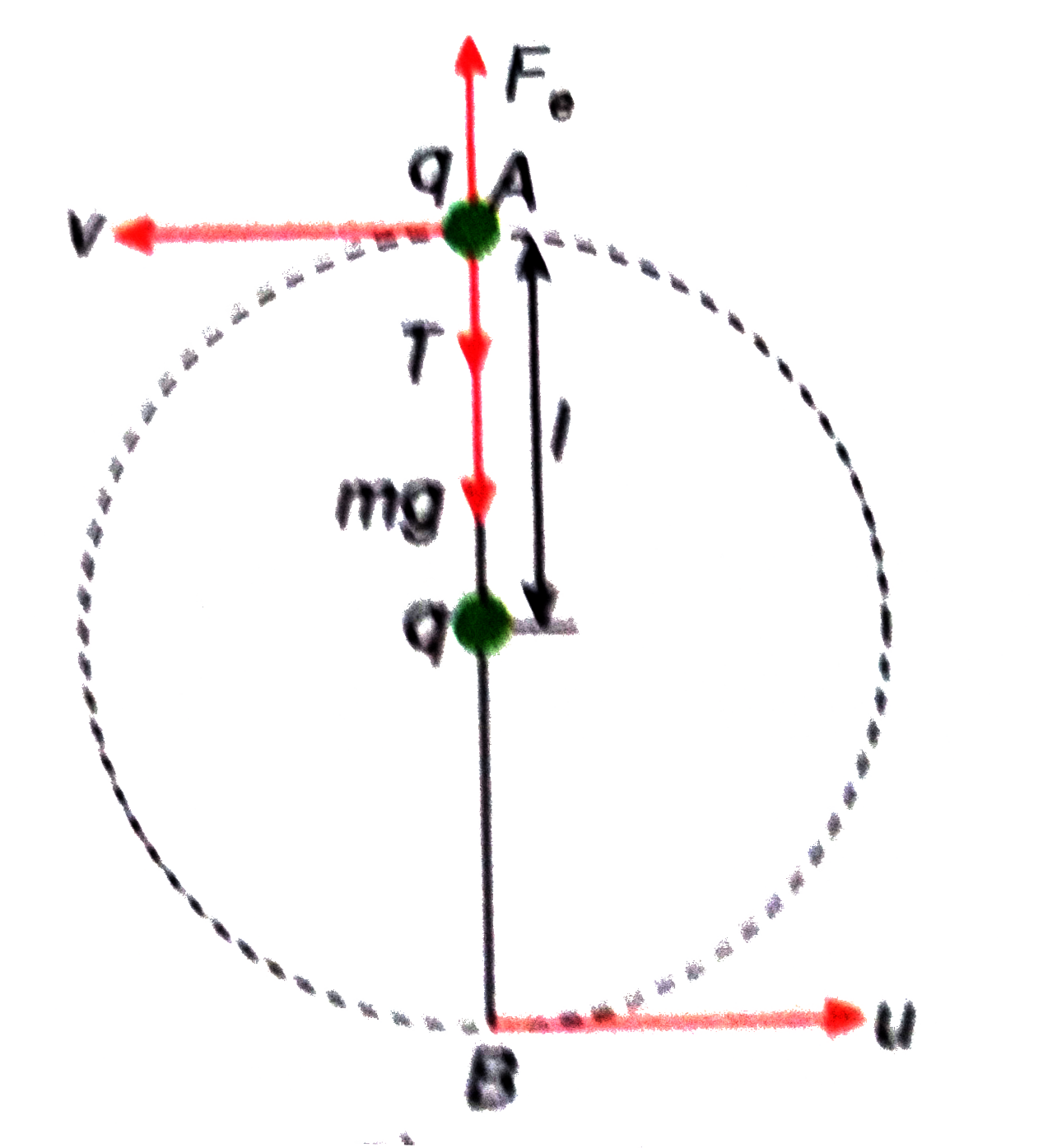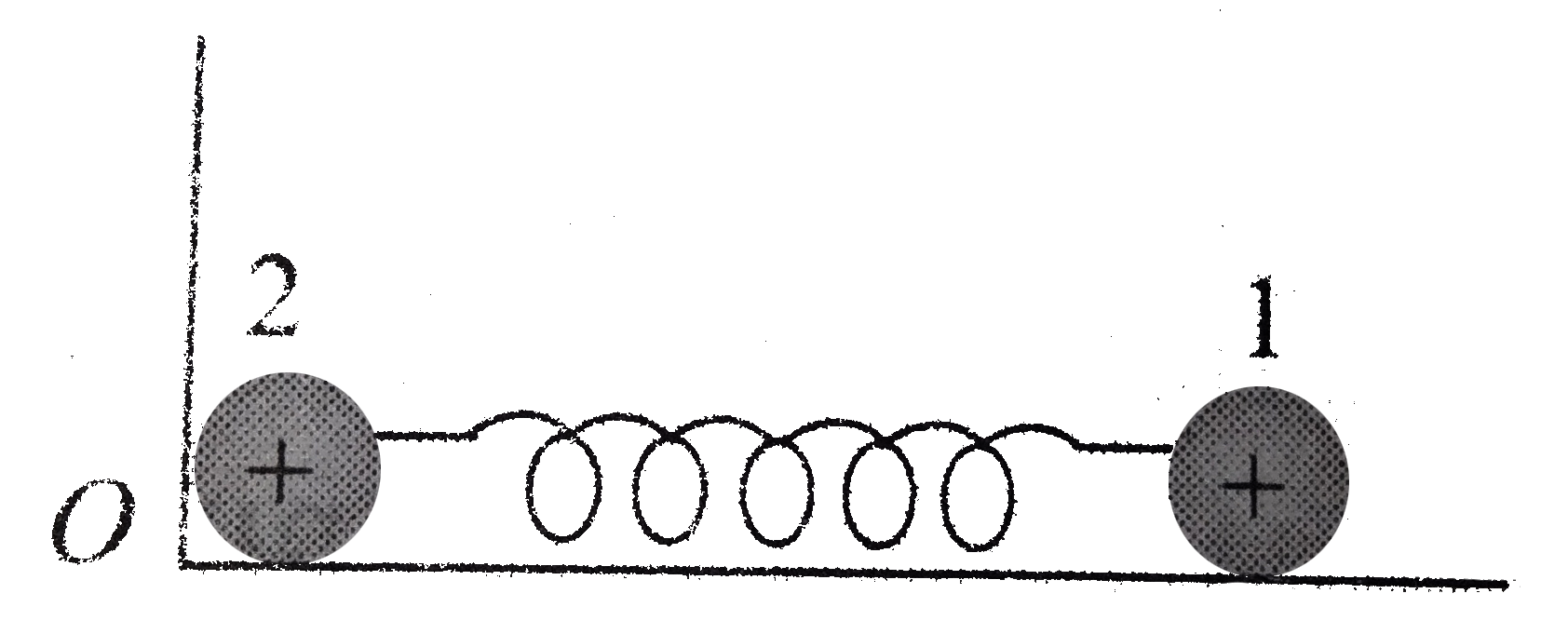A small ball of mass 2×10−3 kg having a charge of 1μC is suspended by a string of length 0.8 m. Another identical ball having the same charge is kept at the point of suspension. Determine the miniumum horizontal velocity which should be imparted to the lower ball, so that it can make complete revolution. Solution in Bengali
Let charge of each ball =q, the radius of the vertices circular path =l and the velocity of the rotating ball at the highest and lowest point of that circular path be v and u respectively.
At the highest point A, three forces act simultaneously which are (1) upward electrostatic force of repulsion, Fe=q2l2. (2) weight of the rotating ball, W =mg (down-wards), (3) tension in the string =T (downwards).

To move in a vertical circular path, the ball should have a minimum velocity at A. In that case, T=0 and the necessary centripetal force is provided by (W−Fe).
∴W−Fe=mv2l
∴v2=lm[mg−q2l2]
Applying the law of conservation of total mechanical energy at A and B we can write,
12mv2+mg×2l=12μ2
or u2=v2=4gl=lm[mg−q2l2]+4gl=5gl−q2ml
∴u=√5gl−q2ml
Hence, minimum horizontal velocity at the lowest point is √5gl−q2ml.
Topper's Solved these Questions
- BOOK - CHHAYA PUBLICATIONCHAPTER - ELECTRIC FIELDEXERCISE - SECTION RELATION QUESTIONS50videos
ELECTRIC FIELD
- BOOK - CHHAYA PUBLICATIONCHAPTER - ELECTRIC FIELDEXERCISE - HIGHER ORDER THINKING SKILL QUESTIONS33videos
ELECTRIC FIELD
- BOOK - CHHAYA PUBLICATIONCHAPTER - ELECTRIC ENERGY AND POWEREXERCISE - CBSE SCANNER7videos
ELECTRIC ENERGY AND POWER
- BOOK - CHHAYA PUBLICATIONCHAPTER - ELECTRIC POTENTIAL EXERCISE - CBSE Scanner13videos
ELECTRIC POTENTIAL
Similar Questions
State Coulomb's law regarding the force of interaction between two point charge. Define the unit of charge from this law.
08:23View SolutionTwo charges, +qand−q are separated by a distance d. At which points will the resultant electric field intensity be directed parallel to the line joining the charges ?
08:09View SolutionA light bulb is rated 100 W for 220 V ac supply of 50 Hz. Calculate
the resistance of the bulb ,04:44View SolutionA test charge q is moved without acceleration along the path from A to B from B to C in electric field E as shown in fig.

(i) Calculate the potential difference between A and C.09:56View SolutionTwo small identical balls lying on a horizontal plane are connected by a weightless spring. One ball (ball 2) is fixed at O, and the other (ball 1) is free. The balls are charged identically as a result of which the spring length increases η=2 times. Determine the change in frequency.
 04:58View Solution
04:58View SolutionA small ball of mass 2×10−3kg, having a charge 1μC, is suspended by a string of length 0.8m. Another identical ball having the same charge is kept at the point of suspension. Determine the minimum horizontal velocity that should be imparted to the lower ball so that it can make a complete revolution.
02:49View SolutionTwo small balls, each having equal positive charge Q are suspended by two insulationg strings of equal length l from a hook fixed to a stand. It mass of each ball =m and total angle between the two strings is 60^(@) m, then find the charge on each ball.
05:43View SolutionA small ball if mass 2 xx 10^(-3) Kg having a charges of 1 mu C is suspended by a string of length 0. 8 m Another identical ball having the same charge is kept at the point of suspension . Determine the minimum horizontal velocity which should be imparted to the lower ball so tht it can make complete revolution .
View SolutionA small ball of mass m having charge q is suspended by a string of length L . Another identical ball having the same charge is kept at the point of suspension. Determine the minimum horizontal velocity which should be imparted to ball at lowest point so that it can make complete revolution.
07:42View SolutionA small positively charged ball of mass m is suspended by an insulating thread of length L. This ball remains in equilibrium with string horizontal when another small charged ball is placed exactly at a distance L below the point of suspension of the first ball. The second ball is slowly moved away from the first ball to a far away point. (The second ball is moved horizontally so that the first ball does not accelerate). As a result the first ball lowers down to the original position of the second ball and the string become vertical. Find the work done by the external agent in removing the second ball.
 View Solution
View SolutionA ball of mass m with a charge q can rotate in a vertical plane at the end of a string of length l in a uniform electrostatic field whose lines of force are directed upwards. What horizontal velocity must be imparted to the ball in the upper position so that the tension in the string in the lower position of the ball is 1.5 times than the weight of the ball?
08:03View SolutionThree small balls, each of mass 10 g , are suspended from a common point by 1-m silk threads . The balls are identically charged and hung at the corners of an equiliteral triangle of 0.1 m. What is the charge on each ball ?
07:07View Solution2×10−3 किग्रा द्रव्यमान की एक छोटी मद जिस पर माइक्रोकृलॉम (μC) का आवेश है, 0.8 मी लम्बी डोरी से लटकी है। एक वैसी ही दूसरी गेंद जिस पर उतना ही आवेश है, निलम्बन बिन्दु (point of suspension) पर स्थित है वह न्यूनतम क्षैतिज वेग ज्ञात कीजिये जिसे निचली गेंद को देने पर, गेंद का एक पूरा चक्कर लगा सके।
05:24View SolutionA small ball suspended from a string is set into oscillation. When the ball passes through the lowest point of the motion, the string is cut. If the ball is then moving with the velocity 0.8 ms−1 at a height of 5 m above the ground, the horizontal distance travelled by the ball is :
(Given g = 10 ms−2 )04:00View Solutionएक 0.8 m लम्बाई की रस्सी से एक गेंद जिसका आवेश 1μC तथा द्रव्यमान 2×10−3Kg है। निलम्बित है निलम्बन बिन्दु पर एक दूसरी गेंद समान द्रव्यमान तथा आवेश की रखी है। लटकी हुई गेंद को निम्नतम कितना क्षैतिज वेग दिया जाये ताकि वह एक पूर्ण चक्कर कर लें।
02:45View Solution

